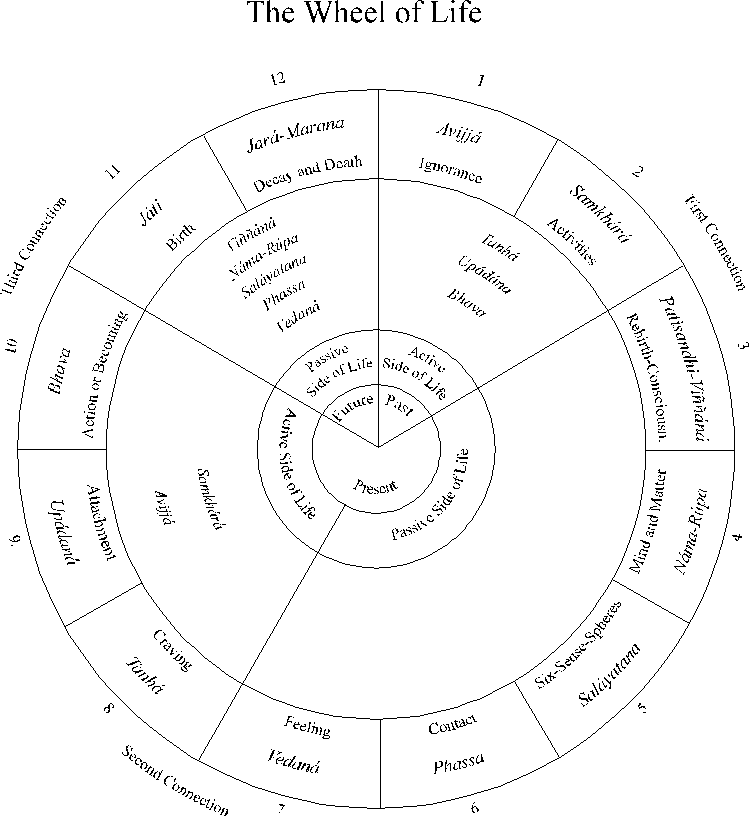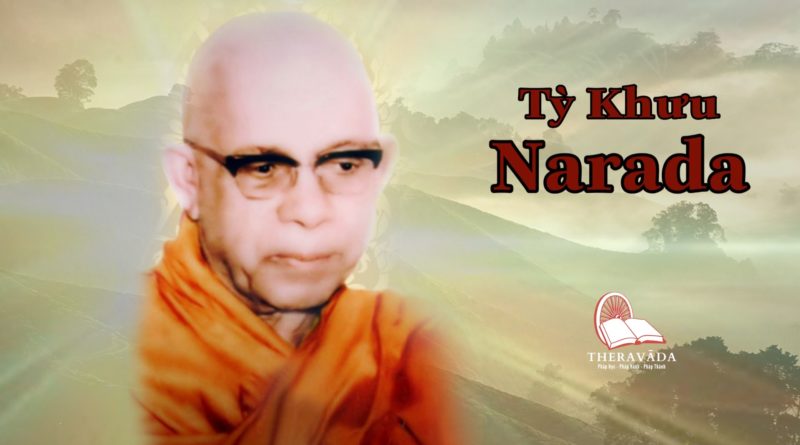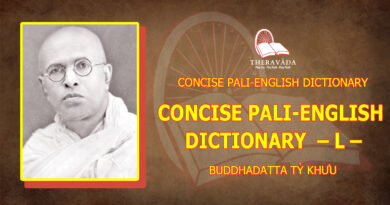Chapter Viii – The Compendium Of Relations
CHAPTER VIII – The Compendium Of Relations
Paccaya – Sangaha – Vibhāgo
§ 1. Yesam, sankhatadhammānam ye dhammā paccayā yathā
Tam vibhāgam ih’edāni pavakkhāmi yathāraham.
§ 2. Paticcasamuppādanayo, Patthānanayo c’āti paccayasangaho duvidho veditabbo.
Tattha tabbhāvabhāvībhāvākāramattopalakkhito paticcasamuppādanayo.
Patthānanayo pana āhaccapaccayatthitam ārabbha pavuccati. Ubhayam pana vomissetvā papañcenti ācariya.
Tattha avijjāpaccayā sankhārā, sankhārāpaccayā viññānam, viññāna-paccayā nāmarūpam, nāmarūpa-paccayā salāyatanam, salāyatana-paccayā phasso, phassa-paccayā vedanā, vedanā-paccayā tanhā, tanhā-paccayā upādānam, upādāna-paccayā bhavo, bhava-paccayā jāti, jāti-paccaya jarā-maranasoka-parideva-dukkha-domanass’ upāyāsā sambhavanti. Evam’ etassa kevalassa dukkhakkhandhassa samudayo hotī’ ti ayam’ettha paticcasamuppādanayo.
Tattha tayo addhā; dvādasangani; vīsatākārā; tisandhi; catusankhepo; tīni vattāni; dve mūlāni ca veditabbāni.
Katham? avijjā, sankhārā atīto addhā; jāti, jarā, maranam anāgato addhā; majjhe attha paccuppanne addhā’ ti tayo addhā.
Avijjā, sankhārā, viññānam, nāmarūpam, salāyatanam, phasso, vedanā, tanhā, upādānam, bhavo, jāti, jarāmaranan’ti dvādasangāni. Sokādivacanam pan’ ettha nissandaphalanidassanam.
Avijjāsankhāraggahanena pan’ettha tanhūpādānabhavā pi gahitā bhavanti. Tathā tanh’ ūpādānabhavaggahanena ca avijjāsankhārā, jātijarāmaranaggahanena ca viññānādiphalapañcakam’eva gahitanti katvā,
Atīte hetavo pañca idāni phalapañcakam
Idāni hetavo pañca āyatim phalapañcakanti
Vīsatākārā, tisandhi, catusankhepā, ca bhavanti.
Avijjā tanhūpādānā ca kilesavattam; kammabhavasankhāto bhav’ekadeso; sankhārā ca kammavattam; upapattibhavasankhāto bhav’ ekadeso; avasesā ca vipākavattanti tīni vattāni.
Avijjātanhāvasena dve mūlani ca veditabbāni.
1. Tesameva ca mūlānam nirodhena nirujjhati
Jārāmaranamucchāya pīlitānam abhinhaso
āsavānam samuppādā avijjā ca pavattati.
2. Vattamābandham iccevam tebhūmakam anādikam
Paticcasamuppādo’ti patthapesi mahāmuni.

The Compendium of Relations
Introductory verse
§ 1. I shall now explain here, in a fitting manner, how causal states act as relations to the conditioned states (1).
§ 2. The compendium of relations is twofold:
A. The Law of Dependent Arising (2), and
B. The Law of Causal Relations (3).
Of these, the Law of Dependent Arising is marked by the simple happening of a state dependent on its antecedent state (4).
The Law of Causal Relations is said with reference to the existence of conditions that relate to one another.
Teachers explain them by mixing both methods.
The Law of Dependent Arising
Therein:
Dependent on Ignorance (5 ) arise Conditioning Activities (6).
Dependent on Conditioning Activities arises (Rebirth) Consciousness (7).
Dependent on (Rebirth) Consciousness arise Mind and Matter (8).
Dependent on Mind and Matter arise the six (Sense) Bases (9).
Dependent on the six (sense) Bases arises contact (10).
Dependent on Contact arises Feeling (11).
Dependent on Feeling arises Craving (12).
Dependent on Craving arises Grasping (13).
Dependent on Grasping arises Action or Becoming (14)
Dependent on Action arises Birth (15).
Dependent on Birth arise Decay, Death, Sorrow, Lamentation, Pain, Grief, and Despair.
Thus arises the whole mass of suffering.
Herein this is the Law of the Dependent Arising.
It should be understood that there are three periods twelve factors, twenty modes, three connections, four divisions, three rounds, and two roots.
How ?
Ignorance and Conditioning Activities belong to the past; Birth, Decay, Death belong to the future; the intermediate eight to the present. Thus there are three periods.
Ignorance, (moral and immoral) Activities, (Rebirth) Consciousness, Mind and Matter, Six Sense Bases, Contact, Feeling, Craving, Grasping, Action, Birth, Decay and Death are the twelve factors. The terms Sorrow and so on are shown as incidental consequences (of Birth).
Here, by taking ignorance and activities, craving, grasping, and action are also taken. Likewise, by taking craving, grasping, and action, ignorance and activities are also taken. By taking birth, decay and death, the five effects with consciousness and so on are taken also. Thus there are:
Five causes pertaining to the past, and five effects to the present; five causes pertaining to the present, and five effects to the future.
There are twenty, modes, three connections and four divisions.
The three Rounds:
1. Ignorance, craving, and grasping belong to the Round of Passions;
2. One part of becoming (bhava) known as action and (moral and immoral) activities belongs to the Round of Kamma.
3. One part of becoming known as renewed existence (upapattibhava) and the rest belong to the Round of Effects.
Ignorance and craving should be understood as the two roots (10) (see diagrams XVI and XVII).
Summary
By the destruction of these roots does the Round cease.
The ignorance, originating from defilements (17), increases in the constantly oppressed who faint by decay and death.
The Great Sage has thus expounded this entangled, beginningless existence in the triple sphere as the ‘Law of Dependent Arising’.
Notes:
1. Sankhatadhammānam – To the conditioned nāma and rūpa described in the previous chapters.
2. Paticcasamuppāda – Paticca = because of, on account of; samuppāda = arising, origination. Although the literal meaning of the term is ‘arising because of’ or dependent arising or origination, it is applied to the whole causal formula which consists of twelve interdependent causes and effects, technically called paccaya and paccayuppanna.
S. Z. Aung renders paticcasamuppādanaya by ‘The Law of happening by way of cause’.
In this chapter the Law of Dependent Arising is not mixed up with the Patthānanaya as in the Visuddhi-Magga.
3. Patthānanaya – According to the Ceylon Commentary here the prefix ‘pa’ means ‘various’ (nānappakāra). Ledi Sayadaw says ‘principal’ (padhāna). Thāna (lit. station) signifies ’cause’ (paccaya) which is paraphrased by ‘upakārakadhamma’ – aiding or supportive conditions. These various or principal causes are described in detail in the Patthānapakarana, the seventh book of the Abhidhamma Pitaka. The system expounded in this treatise is called Patthānanaya.
The difference between the two understood as follows:
i. Because of A arises B. Because of B arises C. When there is no A there is no B. When there is no B there is no C. In other words ‘this being so, that is; this not being so, that is not’ (imasmim sati, idam hoti; imasmim asati, idam na hoti). This is the paticcasamuppādanaya.
ii. When we say that A is related to B in the way of ‘coexistence’, ‘interdependence’, we get an illustration of patthānanaya.
See Journal of the Pāli Text Society, 1915-l916, pp. 21-53.
4. Tabbhāvabhāvībhāvākāramatta;bhāvākāramatta = the simple happening of a state; tabbhāvabhāvī = dependent on its antecedent state.
5. Avijjā, lit., not-knowingness, i.e., of the four Noble Truths. It is also explained as ‘that which causes beings to run in the endless Samsāra’ (antavirahite samsāre satte javāpeti). ‘Whereby the fruit is produced’ is termed ‘paccaya’, which is the cause. When ignorance is destroyed and turned into knowingness, all causality is shattered as in the case of Buddhas and Arahats.
6. Sankhāra – This is a multisignificant term which should be understood according to the context. Here the term signifies immoral (akusala), moral (kusala), and unshakable (āneñjā) volitions (cetanā) which constitute Kamma that produces rebirth. The first embraces all volitions in the 12 types of immoral consciousness; the second, all volitions in the 8 types of Beautiful (kusala) consciousness and the 5 types of kusala rūpa-jhānaconsciousness; the third, all volitions in the 4 types of kusala arūpa-jhānas. Where is no proper English equivalent which gives the exact connotation of this Pāli term. Sankhārā, as one of the five aggregates, implies the 50 mental states excluding feeling and perception.
The volitions of the four supramundane Path consciousnesses (lokuttara-magga-citta) are not regarded as sankhārā because they tend to eradicate ignorance. Wisdom (paññā) is predominant in Supramundane types of consciousness, while volition (cetanā) is predominant in the mundane types of consciousness.
Ignorance is predominant in immoral activities, while it is latent in moral activities. Hence both moral and immoral actions are regarded as caused by ignorance.
7. Viññāna – strictly denotes the 19 types of rebirth-consciousness (patisandhi viññāna) described in chapter V. All the 32 types of resultant consciousness (vipāka-citta) experienced during lifetime, are also implied by the term.
The foetus in the mother’s womb is formed by the combination of this relinking-consciousness with the sperm and ovum cells of the parents. In this consciousness are latent all the past impressions, characteristics and tendencies of that particular individual life-flux.
This relinking-consciousness is regarded as “radiant” (pabhassara) as it is either devoid of immoral roots of lust, hatred and delusion (as in the case of rootless resultants – ahetuka-vipāka), or accompanied by moral roots (as in the case of resultants with roots).
8. Nāma-rūpa – This compound should be understood as nāma alone, rūpa alone, and nāmarūpa together. In the case of arūpa planes there arises only mind; in the case of mindless (asañña) planes, only matter; in the case of kāma and rūpa planes, both mind and matter.
By nāma are here meant the three aggregates – feeling (vedanā), perception (saññā) and sankhārā – that arise simultaneous with rebirth-consciousness. By rūpa are meant the three decads* kāya,bhāva-vatthu – that also arise simultaneous with rebirth-consciousness conditioned by past kamma. The second and third factors pertain to the past and present. The third and fourth factors, on the contrary, are contemporaneous.
* The body decad (kāyadasaka) is composed of tbe four elements, namely, i. the element of extension (pathavi), ii. the element of cohesion (āpo), iii. the element of heat (tejo), iv. the element of motion (vāyo); its four derivatives (upūdārūpa) – namely, v. colour (vanna), vi. odour (gandha), vii. taste (rasa), viii. nutritive essence (oja), with ix. vitality (jīvitindriya), and x. body (kāya).
Sex-decad (bhavadasaka) and base-decad (vatthudasaka) also consist of the first nine and sex and seat of consciousness respectively.
From this it is evident that sex is determined by past Kamma at the very conception of the being.
Here kāya means the sensitive part of the body. Sex is not developed at the moment of conception but the potentiality is latent. Neither the heart nor the brain, the supposed seat of consciousness, is developed but the potentiality of the seat is latent.
9. Salāyatana – During the embryonic period the six sense-bases gradually evolve from the psycho physical phenomena in which are latent infinite potentialities. The insignificant, infinitesimally small speck now develops into a complex six-sense-machine which now operates almost mechanically without any agent like a soul to act as the operator. The six sense-bases are eye, ear, nose, tongue, body, and mind. The first five refer to the sensitive organs that evolve by degrees. Mind-base has already been explained.
10. Phassa – See Chapters 1 and 2.
11. Vedanā – Ibid.
12. Tanhā (Craving) is threefold, namely, craving for sensual pleasures (kāma-tanhā), craving for sensual pleasures associated with the view of eternalism (bhava-tanhā) i.e., enjoying, pleasures thinking that they are imperishable, and craving for sensual pleasures associated with the view of nihilism (vibhava-tanhā) i.e., enjoying pleasures thinking that everything perishes after death. The last is the materialistic point of view.
Bhava-tanhā and vibhava-tanhā are also interpreted as attachment to rūpa and arūpa Planes respectively. Usually these two terms are rendered by craving for existence and non-existence.
There are six kinds of craving corresponding to the six sense-objects such as form, sound, and so on. They become 12 when they are treated as internal and external. They are reckoned as 36 when past, present and future are taken into consideration. When multiplied by the foregoing three kinds of craving they amount to 108.
13. Upādāna, derived from upa + ā + Ö da, to give, is intense craving or firm grasping. Tanhā is like groping in the dark to steal an object. Upādāna corresponds to the actual stealing. Grasping results with attachment and error. It gives rise to the false notions of ‘I’ and ‘mine’.
14. Bhava, lit., becoming, is explained as both moral and immoral action which constitute Kamma (kamma-bhava) – active process of becoming – and the different planes of existence (upapattibhava) – passive process of becoming. The only difference between sankhāra and kammabhava is that the former pertains to the past and the latter to the present. It is only the (kamma) bhava that conditions the future birth.
15. Jāti, strictly speaking, is the arising of the aggregates (khandhānam pātubhāvo). Ignorance is shown as the past cause that conditions the present, and Craving as the present cause that conditions the future.
17. āsavas or Defilements, latent in all worldlings, are cited as the cause of ignorance.
Patthānanayo
§ 3. (1) Hetupaccayo, (2) ārammanapaccayo, (3) adhipatipaccayo, (4) anantarapaccayo, (5) samanantarapaccayo, (6) sahajātapaccayo, (7 ) aññamaññapaccayo, (8) nissayapaccayo, (9) upanissayapaccayo, (10) purejātapaccayo, (11) pacchājātapaccayo, (12) āsevanapaccayo, (13) kammapaccayo, (14) vipākapaccayo, (15) āhārapaccayo, (16) indriyapaccayo, (17) jhānapaccayo, (18) maggapaccayo, (19) sampayuttapaccayo, (20) vippayuttapaccayo, (21) atthipaccayo, (22) natthipaccayo, (23) vigatapaccayo, (24) avigatapaccayo’ ti ayamettha patthananayo.
i. Chadhā nāmantu nāmassa pañcadhā nāmarūpinam
Ekadhā puna rūpassa rūpam nāmassa c’ekadhā.
ii. Paññattināmarūpāni nāmassa duvidhā dvayam
Dvayassa navadhā c’āti chabbidhā paccayā katham.
A. Anantaraniruddhā cittacetasikā dhammā paccuppannānam citta cetasikānamanantara samanantaranatthi-vigatavasena; purimāni javanāni pacchimānam javanānam āsevanavasena; sahajātācittacetasikā dhammā aññamaññam sampayuttavasenā’ti chadhā nāmam nāmassa paccayo hoti.
B. Hetujhānangamaggangāni sahajātānam nāmarūpanam hetādivasena; sahajāta cetanā sahajātānam nāma rūpānam; nānakkhanikā cetanā kammābhinibbattānam nāmarūpānam kammavasena; vipākakkhandha aññamaññam saha jātānam rūpānam vipākavasenāti ca pañcadhā nāmam nāmārūpānam paccayo hoti.
C. Pacchājātā cittacetasikā dhammā purejātassa imassa kāyassa paccājātavasen’āti ekadhā va nāmam rūpassa paccayo hoti.
D. Chavatthūni pavattiyam sattannam viññānadhātunam; pañcalambanāni ca pañcaviññānavīthiyā purejātavasenāti ekadhā va rūpam nāmassa paccayo hoti.
E. ārammanavasena upanissyavasenā’ti ca duvidhā paññattlnāmarūpāni nāmass’ eva paccaya honti.
Tattha rūpādivasena chabbidham hoti ārammanam.
Upanissayo pana tividho hoti – ārammanūpanissayo, anantarūpanissayo, pakatūpanissayo c’āti. Tatth’ālambanam eva garukatam ārammanūpallissayo. Anantaraniruddha cittacetasikā dhamma anantarūpanissayo. Rāgādayo pana dhammā saddhādayo ca sukham dukkham puggalo bhojanam utu senāsanañ ca yathāraham ajjhattam ca bahiddhā ca kusalādidhammānam kammam vipākānanti ca bahudhā hoti pakatūpanissayo.
F. Adhipati, sahajāta, aññamañña, nissaya, āhāra, indriya, vippayutta, atthi, avigatavasenā’ti yathāraham navadhā nāmarūpāni nāmarūpānam paccayā bhavanti.
Tattha garukatamālambanam alambanādhipativasena nāmānam sahājadhipati catubbidho’ pi sahajātavasena sahajātānam nāmarūpānanti ca duvidho hoti adhipati-paccayo.
Cittacetasikā dhammā aññamaññam sahajātarūpānañ ca, mahābhūta aññāmaññam upādārūpānañ ca, patisandhikkhane vatthuvipākā aññamaññanti ca tividho hoti sahajātapaccayo.
Cittacetasikā dhammā aññamaññam, mahābhūta aññamaññam patisandhikkhane vatthuvipākā aññamaññanti ca tividho hoti aññamaññapaccayo.
Cittacetasikā dhammā aññamaññam sanajātarūpānañ ca mahābhūtā aññamaññam upādārupānañ ca chavatthūni sattannam viññānadhātūnanti ca tividho hoti nissayapaccayo.
Kabalīkāro āhāro imassa kāyassa, arūpino āhārā sahājātānam nāma rūpanan’ti ca duvidho hoti āhārapaccayo.
Pañcappasādā pañcannam viññānānam, rūpajīvitindriyam upādinnarūpānam, arūpino indriyā sahajātānam nāmarūpananti ca tividho hoti indriyapaccayo.
Okkantikkhane vatthuvipākānam, cittacetasikā dhammā sahajātarūpanam sahajātavasena, pacchājātā cittacetasikā dhammā purejātassa imassa kāyassa pacchājātavasena, cha vatthūni pavattiyam sattannam viññānadhātūnam purejātavasenā’ti ca tividho hoti vippayuttapaccayo.
Sahajātam purejātam pacchājātam ca sabbathā
Kabalīkāro āhāro rūpajīvitamiccayanti.
Pañcavidho hoti atthipaccayo avigatapaccayo.
ārammanūpānissaya-kamma-atthipaccayesu ca sabbe’pi paccaya samodhānam gacchanti.
Sahajātarūpanti pan’ettha sabbatthā’pi pavatte cittasamutthānānam patisandhiyam katattārūpānañ ca vasena duridho hoti veditabbam.
Iti tekālikā dhammā kālamutta ca sambhavā
Ajjhattañ ca bahiddhā ca sankhatāsankhatā tathā
Paññattināmarūpānam vasena tividhā thitā
Paccayā nāma patthāne catuvīsati sabbathā’ti.
The Law of Casual Relations
§ 3. The following are the causal relations:
1. Root (18) Condition
2. Object (19) “
3. Predominance (20) “
4. Contiguity (21) “
5. Immediacy (21) “
6. Conascence (22) “
7. Mutuality (or Reciprocity) (23) “
8. Dependence (24) “
9. Powerful Dependence (or Sufficing) (24) “
10. Pre-nascence (or Antecedence) (24) “
11. Post-nascence (or Post occurrence) (26) “
12. Repetition (or Habitual Recurrence) (27) “
13. Kamma (28) “
14. Effect (29) “
15. Nutriment (30) “
16. Control (31) “
17. Jhāna (32) “
18. Path (23) “
19. Association (34) “
20. Dissociation (36) “
21. Presence (36) “
22. Absence (37) “
23. Separation (38) “
24. Non-separation (38) “
Herein this is the law of causal relations.
In six ways mind is related to mind. In five ways mind is related to mind and matter. Again mind is related in one way to matter, and matter in one way to mind. In two ways concepts, mind and matter are related to mind. In nine ways are the two – mind and matter – related to mind and matter. Thus the relations are sixfold.
Relations of Mind and Matter
How?
A. In six ways mind is related to mind:
Consciousness and mental states that immediately cease, relate themselves to present consciousness and mental states by way of contiguity, immediacy, absence and separation.
Preceding Javanas are related to the subsequent, Javanas by way of repetition (or habitual recurrence). Coexisting consciousness and mental states are related to one another by way of association.
B. In five ways mind is related to mind and matter:
Root, Jhāna and Path factors are related to coexisting mind and matter by way of root, etc.
Coexisting volition is related to coexisting mind and matter and asynchronous volition to mind and matter born of Kamma by way of Kamma.
The (mental) aggregates of effect are related to one another and coexistent matter by way of effect.
C. Only in one way is mind related to matter:
Subsequent consciousness and mental states are related to this preceding (material) body by way of post-occurrence.
D. Only in one way is matter related to mind:
The six bases during life are related to the seven elements of cognition, and the five objects to the five processes of sense-cognition by way of antecedence.
E. In two ways are concepts, mind and matter related to mind – namely, by way of object and powerful dependence.
Therein object is sixfold as form, etc. But powerful dependence is threefold – namely, powerful dependence as object, powerful dependence as contiguity, and powerful dependence as intrinsic nature.
Of them the object itself when it becomes prominent serves as a powerful dependence of the object. Consciousness and mental states that immediately cease, act as the powerful dependenceof proximity. The powerful dependence of intrinsic nature is of several kinds: states of lust, etc., states of confidence, etc., pleasure, pain, individual, food, season, lodging conditions, internal and external, as the case may be, are related to moral states, etc. Kamma, too, is similarly related to its effects.
F. Mind and matter are related to mind and matter in nine ways according to circumstances – namely, by way of predominance, conascence, reciprocity, dependence, nutriment, control, dissociation, presence, and non separation.
Therein relation of predominance is twofold:
i. The object to which weight is attached is related to states of mind by way of objective predominance.
ii. The fourfold coexisting predominance is related to coexisting mind and matter by way of conascence.
The relation of conascence is threefold: consciousness and mental states are related to one another and to the coexisting material states; the four Great Essentials mutually and to the derived material qualities; the heart-base and the resultant (mental aggregates) to one another at the moment of rebirth.
The relation of reciprocity is threefold: consciousness and mental states are related to one another; the four Great Essentials, to one another; the heart-base and the resultant mental aggregates to one another at the moment of rebirth.
The relation of dependence is threefold: consciousness and mental states are related to one another and coexisting matter; the four chief elements, to one another and derived material qualities; and six bases, to the seven cognitive elements.
The relation of nutriment is twofold: edible food is related to this body; and immaterial nutriment, to the coexisting mind and matter.
The relation of control is threefold: the five sensitive organs are related to the five kinds of cognition; the controlling power of material vitality, to the material qualities that have been grasped at; the immaterial controlling factors, to the coexistent mind and matter.
The law of dissociation is threefold: at the moment of conception the basis of mind is related to the effects (of kamma), and consciousness and mental states, to coexistent mind and matter by way of coexistence; the subsequent consciousness and mental states, to this antecedent body by way of post-occurrence; the six bases, in the course of life, to the seven cognitive elements by way of antecedence.
The five kinds of relations – coexistence, antecedence, post-occurrence, edible food, and material life – are, in every way, in the relation of presence and of non-separation.
All relations are included in the relations of object, powerful dependence, Kamma and presence.
Herein coexisting material qualities should be understood as twofold throughout the course of life they should be understood as those born of mind, and at rebirth as those born of kamma.
Summary
Thus the relative conditions pertaining to the three periods of time and timeless, internal and external, conditioned and non-conditioned, are threefold by way of concept, mind and matter.
In all, the relations in Patthāna are twenty-four.
Notes:
18. Hetu-paccaya – Here paccaya presents some difficulty. It is defined as that by means of which an effect comes to be. In other words it is the cause. Furthermore, it is explained as a ‘serviceable or supportive factor’ (upakārako dhammo).Hetu is defined as ‘that by which an effect is established’. It is used in the sense of ‘root’ (mūlatthena). Like the roots of a tree are hetu; like water and manure that aid its growth are paccaya. In the Abhidhamma these two related terms are used in two different senses. In the Suttas, however, they are invariably employed as Synonymous terms, without any distinction, as, for example ko hetu, ko paccayo – what is the reason? what is the cause?
In the Patthāna 24 such paccayas are enumerated, and hetu is one of them. Hetu-paccaya is explained as ‘hetu itself is a paccaya’ or ‘as hetu it becomes a paccaya’. It is interpreted as a supportive or serviceable factor in the sense of root (mūlatthena upakārako dhammo). The causal relation by way of ‘root’ may be suggested as the closest rendering. (See Compendium, p. 279; Journal of the Pāli Text Society, 1915-1916, pp. 29-53.)
‘Roots are purely mental. They are the six moral and immoral roots. See Chapter 1.
19. ārammana – or ālambana. The former is derived from a + Ö ram, to delight in; the latter from ā + Ö lamb, to hang upon. Things which the subject delights in or hangs upon are ‘objects’. There are six classes of objects. A form, for instance, acts as a causal relation to visual-consciousness by way of an ‘object’. It should be stated that there is nothing mundane or supramundane that does not become an object for mind.
20. Adhipati – Lit., mastery or lordship over one’s own. 0ne of the four dominant factors – namely, wish, thought, effort and reasoning – may, at one time, causally relate itself to coexistent mental states and material phenomena by way of predominance. “Whenever such phenomena as consciousness and mental states arise by giving predominance to one of these four factors, then this phenomenon is to the other phenomenon a condition by way of predominance”. (Patthāna)
21. Anantara and Samanantara – In meaning there is no difference between the two terms. They differ only in etymology. According to Buddhist philosophy one thought-moment perishes, immediately giving birth to another. The succeeding thought-moment inherits all the potentialities of its immediate predecessor. The perishing preceding states causally relate themselves to immediately following states by way of contiguity and immediacy.
22. Sahajāta – The causal relation by way of conascence, as, for instance, the four mental aggregates, the different mental states that simultaneously arise in a particular type of consciousness, the four Great Essentials that arise together, the appearance of the three ‘decads’ at the moment of conception, etc. In the paticca–samuppāda it may be mentioned that both contact and feeling which appear as causes and effect are conascent.
A mental state may be conascent with a mental state, a mental with a physical, a physical with a physical, and a physical with a mental.
23. Aññamañña – Just as the legs of a tripod are reciprocally helpful, even so mental or physical state or states may be causally related by way of reciprocity (or mutuality). Causal relations of conascence and reciprocity should be differentiated. They are not identical. For instance, mind-born material phenomena are not reciprocally related to the coexisting mind, nor are the material derivatives to the coexisting Great Essentials. As a rule, mind and matter are reciprocally related.
24. Nissaya and Upanissaya – derived from upa + ni + Ö si, to lie. Upa is an intensive prefix. As trees depend on the ground for their support, and as pictures depend on a canvas on which they are painted, so is the causal relation of dependence. Upanissaya is defined as a stronger form of Nissaya. It is compared to the rains on which depend the growth of trees. S. Z. Aung renders upanissaya by ‘sufficing condition’. For instance, one of the five heinous crimes such as matricide, parricide and so on, will serve as an upanissaya to effect a birth in a woeful state. Good environments, early education, etc., will serve as a causal relation by way of ‘dependence’ (nissaya) for the acquisition of health, wealth and knowledge in later life. Just as good actions become upanissaya for future good deeds, even so they may become upanissaya for evil too as, for instance, spiritual pride. See Ledi Sayadaw’s learned article on this subject in P.T.S. Journal, 1916, pp. 49-53.
25. Purejāta – lit., born before or that which pre-exists. The six physical bases and six sensual objects are regarded as pre-existent. The pre-existent things are regarded as causal relations only when they continue to exist in the present and not by mere antecedence. Priority is not a good rendering.
26. Pacchājāta – Of the 89 types of consciousness, 85 types, excluding the four arūpa resultants, and the 52 mental states, are causally related to the antecedent physical body by way of post-occurrence.
27. āsevana – Repeated practice, as a rule, leads to proficiency. This applies to both good and evil things. By repetition one acquires a certain amount of skill in any particular thing. āsevana denotes this repeated practice. In javana process the second thought moment is causally related to the first, the third to the second, the fourth to the third, by way of recurrence. This is the reason why the fourth javana thought-moment is considered very powerful.
28. Kamma means the volition that plays the most important part in moral and immoral thoughts, words, and deeds. This volition, technically known as Kamma, is causally related to the Kamma-born material phenomena, etc. As a seed to a tree so is Kamma causally related to its inevitable results.
29. Vipāka – Like a cool breeze that pacifies a person seated under the cool shade of a tree, even so mental states of resultant types of consciousness are causally related to coexistent mental states and material phenomena by way of ‘effect’ due to their effortless peaceful nature.
30. āhāra – Just as material food sustains the physical body, even so mental foods sustain mental states. Edible food is causally related to the body by way of nutriment or food; so are mental contacts or impressions (phassa) to feelings; volitions or moral and immoral actions (mano-sañetanā) to rebirth-consciousness (patisandhi viññāna); and rebirth-consciousness (viññāna) to mind and matter.
31. Indriya – The controlling factors enumerated in Chapter VII become causally related to the coexistent mental states and material phenomena because they exercise control in their respective spheres. For instance, confidence controls its co-adjuncts in religious convictions; psychic and physical life, in vivifying mind and matter; mindfulness, in contemplative exercise; feelings, in grief and happiness, etc.
32. Jhāna – The seven jhāna factors of (1) initial application, (2) sustained application, (3) rapture, (4) happiness, (5) equanimity, (6) displeasure and (7) one-pointedness are causally related to one another and other concomitants by way of close perception and contemplation. For instance, the initial application (vitakka) is causally related to its concomitants in directing them towards the desired object. See Chapter 1.
1, 2, 3, 4, 7 are found in two classes of consciousness rooted in attachment; 1, 2, 6, 7, in hateful consciousness; 1, 2, 5, 7, in deluded consciousness.
33. Magga – means a way or road. One way leads to woeful states; the other, to states of bliss. The vehicles that convey travelers to the former are the evil ‘Path Constituents’ of wrong views, wrong application, wrong effort, and wrong one-pointedness. The vehicles that ply on the latter way are right understanding, right aspirations, right speech, right action, right livelihood, right effort, right mindfulness, and right one-pointedness. These path factors are causally related to both mind and body, leading downwards in the case of bad ones, and leading away from existence (niyyāna) in the case of good ones.
34. Sampayutta – Though possessing distinct characteristics from an ultimate standpoint yet, as certain mental states arise together, perish together, have one identical object and one identical base, they are causally related to one another by way of ‘association’.
35. Vippayutta is the opposite of the foregoing. Sweet and bitter tastes may be helpful to each other in being dissimilar. For instance, mind that depends on the heart-basis is causally related to it by way of dissociation because, both mind and heart-basis are not mutually bound, as water on a lotus leaf.
36. Atthi is the causal relation of states that exist in the present to similar states like the causal relation of coexistence. The visibility of objects, for instance, is due to the presence of light.
37. Natthi – As with the disappearance of light, darkness spreads, so with the disappearance of the predecessor, the successor appears. Such is the causal relation by way of absence. For instance, the visual consciousness (dassana) is causally related to the immediately following receiving consciousness (sampaticchana) by way of absence.
38. Vigata and Avigata are similar to Natthi and Atthi respectively.
Paññattibhedo
§ 4. Tattha rūpadhamma rūpakkhandho ca cittacetasikāsankhātā cattāro arūpino khandhā nibbānañc’ āti pañcavidham pi arūpanti ca nāman’ ti ca pavuccati.
Tato avasesā paññatti pana paññāpiyattā paññatti, paññāpanato paññattī’ti ca duvidha hoti.
Katham? Tam tam bhūtaparināmākāramupādāya tathā tathā paññattā bhūmipabbatādikā, sasambhārasannivesākāram upādāya geharathasakatādikā, khandhapañcakam upādāya purisapuggalādikā, candāvattanādikam upādāya disākālādika, asamphutthākāram upādāya kūpaguhādikā, tamtam bhūtanimittam bhāvanāvisesañ ca upādāya kasinanimittādikā cā’ti evamādippabhedā pana paramatthato avijjamānā ‘pi atthacchāyākārena cittuppādānāmālambanabhūtā tam tam upādāya upanidhāya kāranarn katvā tathā tathā parikappiyamānā sankhāyati, samaññāyati, voharīyati, paññāpīyatī’ ti paññattī’ti pavuccati. Ayam paññatti paññāpiyattā paññatti nāma.
Paññāpanato paññatti pana nāma nāmakammādināmena paridīpitā.
Sa vijjamānapaññatti, avijjamānapaññatti,vijjamānena avijjamāna paññatti, avijjamānena vijjamānapaññatti, vijjamānena vijjamānapaññatti, avijjamānena avijjamānapaññatti c’āti chabbidhā hoti.
Tattha yadā pana paramatthato vijjamānam rūpavedanādim etāya paññāpenti tadāyam vijjamānapaññatti. Yadā pana paramatthato avijjamānam bhūmipabbatādim etāya paññāpenti, tadāyam avijjamānapaññattīti pavuccati. Ubhinnam pana vomissakavasena sesā yathākkamam chalabhiñño, itthisaddo, cakkhuviññānam, rājaputto’ti ca veditabbā.
Vacīghosānusārena sotaviññānavīthiyā
Pavattānantaruppanna manodvārassa gocarā.
Atthāyassānusārena viññāyanti tato param
Sāyam paññatti viññeyyā lokasanketanimmitā’ti
Iti Abhidhammatthasangahe Paccayasangahavibhāgo nāma atthamo paricchedo.
Paññatti
§ 4. Therein the material states are just the aggregates of matter.
Consciousness and mental states, which comprise the four immaterial aggregates, and Nibbāna, are the five kinds that are immaterial. They are also called ‘name’ (nāma).
The remaining paññatti (39) is twofold, inasmuch as it is made known, or as it
makes known.
How?
There are such terms as ‘land’, ‘mountain’, and the like, so designated on account of the mode of transition of the respective elements; such terms as ‘house’, ‘chariot’, ‘cart’, and the like, so named on account of the mode of formation of materials; such terms as ‘person’ ,’individual’, and the like, so named on account of the five aggregates; such terms as ‘direction’, ‘time’, and the like, named according to the revolution of the moon and so forth; such terms as ‘well’, ‘cave’, and the like, so named on account of the mode of non-impact and so forth; such terms as Kasina-objects and the like, so named on account of respective elements and different mental culture.
All such different things, though they do not exist in an ultimate sense, become objects of thought in the form of shadows of (ultimate) things.
They are called ‘paññatti’ because they are thought of, reckoned, understood, expressed, and made known on account of, in consideration of, with respect to, this or that mode.
This ‘paññatti’ is so called because it is made known.
As it makes known it is called ‘paññatti’. it is described as ‘name’, ‘name-made, etc.
It is sixfold (40):
1. A real concept, 2. an unreal concept, 3. an unreal concept by means of a real concept, 4. a real concept by means of an unreal concept, 5. a real concept by means of a real concept, 6. an unreal concept by means of an unreal concept.
As, for instance, when they make known by a term, such as ‘matter’, ‘feeling’, and so forth, that exist in reality, it is called a ‘real concept’.
When they make known by a term, such as ‘land’, ‘mountain’ and so forth, that do not exist in reality, it is called an ‘unreal concept’.
The rest should respectively be understood by combining both as, for instance, ‘possessor of sixfold supernormal vision’, ‘woman’s voice’, ‘visual cognition’, ‘king’s son’.
Summary
By following the sound of speech through the process of auditory consciousness, and then by means of the concept conceived by mind-door that subsequently arises, are meanings understood.
These concepts should be understood as fashioned by world-convention.
This is the eighth chapter which deals with the Analysis of Causal Relations in the Compendium of Abhidhamma.
Notes:
39. Paññatti – There are two kinds of paññatti or concepts – namely, attha-paññatti and nāma-paññatti. The former is made known, that is, the object conveyed by the concept. The latter is that which makes known, that is, the name given to the object.
Land, mountain, etc. are called ‘santhāna-paññatti’, formal concepts, since they correspond to the form of things.
Chariot, village, etc., are called ‘samūha-paññatti’, collective concepts, since they correspond to a collection or group of things.
East, west, etc., are called ‘disā-paññatti’, local concepts, since they correspond to locality.
Morning, noon, etc., are called ‘kāla-paññatti’, time concepts, since they correspond to time.
Well, cave, etc., are called ‘ākāsa-paññatti’, space-concepts, since they correspond to open space.
Visualized image, conceptualized image, etc. are called ‘nimitta-paññatti’, since they correspond to mental signs gained by mental development.
40. Six kinds of Paññatti –
1. Matter, feeling, etc., exist in an ultimate sense.
2. Land, mountain, etc., are terms given to things that do not exist in an ultimate sense.
3. ‘Possessor of sixfold supernormal vision.’
Here the former does not exist in an ultimate sense, but the latter does.
4. Woman’s voice. Here the voice exists in an ultimate sense, but not the woman.
5. Eye-consciousness. Here the sensitive eye exists in an ultimate sense, and so does the consciousness dependent on it.
6. King’s son. Here neither the son nor the king exists in an ultimate sense.








